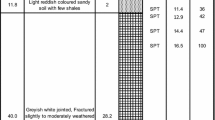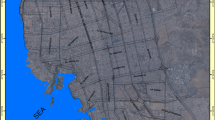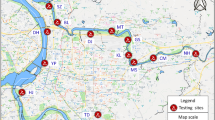Abstract
During the last decades, there has been an increase in the use of geophysical tests for geotechnical characterization. The relatively low cost and the large volume analysed by non-invasive geophysical testing makes them very attractive for a site investigation plan combined with borings and other geotechnical tests. In some countries, for instance Portugal, the use of multichannel analysis of surface waves (MASW) and other surface wave methodologies is still limited. This work shows results obtained with the use of MASW in the geotechnical investigation of the foundation soils of a viaduct and a bridge, part of the IC3 route, with a total length of about 10 km. The study area is located very near the “Lower Tagus valley” active fault and above thick alluvial deposits. Comparisons of MASW with other in situ tests show that the results are in good agreement. The N(SPT)-V S correlations are still in use worldwide for practical purposes, but not always considering all the important parameters as the standard penetration test (SPT) energy measurement. In this paper, we discuss the usability of empirical correlations to obtain the shear wave velocity from SPT results, using the results from the case study presented. The large variability of results obtained proves the importance of measuring the shear wave velocity with geophysical tests.












Similar content being viewed by others
References
Akin MK, Kramer SL, Topal T (2011) “Empirical correlations of shear wave velocity (V S) and penetration resistance (SPT-N) for different soils in an earthquake-prone area (Erbaa-Turkey). Eng Geol 119:1–17
Ansal A, Erdik M, Kurtulus A, Erken A, Sesetyan K, Siyahi B, Springman S, Laue J (2003) Microzonation in Turkey. Reference information. State of the art, MERM Project; World Institute for Disaster Risk Management
ASTM D-1586–99 (1999) Standard test method for penetration test and split-barrel sampling of soils. Subcommittee: D18.02, Book of standards volume: 04.08
ASTM D 4633–05 (2005) Standard test method for energy measurement for dynamic penetrometers. Subcommittee: D18.02
Athanasopoulos GA (1995) Empirical correlations Vso-NSPT for soils of Greece: a comparative study of reliability. In: Proceedings of seventh international conference on Soil Dynamics, Earthquake Engineering. Computation Mechanics Publications, Southampton, Boston, pp 19–25
Bellana N (2009) Shear wave velocity as a function of SPT penetration resistance and vertical effective stress at California bridges sites. Master thesis in Civil and Environmental Engineering. University of California LA
Boore DM (2004) Estimating Vs (30) (or NEHRP site classes) from shallow velocity models (depths > 30 m). BSSA 94(2):591–597
Cenorgeo (2007) IC3—Vila Nova da Barquinha/Chamusca—New Tagus river crossover. Geological and geotechnical study. Execution Project. (in Portuguese)
Cercato M (2009) Addressing non-uniqueness in linearized nultichannel surface wave inversion. Geophys Prospect 57:27–47
Constable SC, Parker RL, Constable CG (1987) Occam’s inversion: a practical algorithm for generating smooth models from electromagnetic sounding data. Geophysics 52(3):289–300
DeJong JT (2007) Site characterization—guidelines for estimating Vs based on in situ tests. Stage 1—interin report. Soil Interactions Laboratory. UC DAVIS, p 22
Dikmen U (2009) Statistical correlations of shear wave velocity and penetration resistance for soils. J Geophys Eng 6:61–72
Dineva S, Batlo J, Mihaylov D, van Eck T (2002) Source parameters of four strong earthquakes in Bulgaria and Portugal at the beginning of the 20th century. J Seismolog 6(1):99–123
Dobry R, Borcherdt RD, Crouse CB, Idriss IM, Joyner WB, Martin GR, Power MS, Rinne EE, Seed RB (2000) New site coefficients and site classification system used in recent building seismic code provisions (1994/1997 NEHRP and 1997 UBC). Earthquake Spectra 16:41–68
Dunkin JW (1965) Computation of modal solutions in layered, elastic media at high frequencies. Bull Seismol Soc Am 55(2):335–358
EC7 (2007). Eurocode 7. Geotechnical design. Part 2: ground investigation and testing. EN 1997-2:2007. CEN
EC8 (2010) Eurocode 8. Design of structures for earthquake resistance. Part 1: general rules, seismic actions and rules for buildings. NP EN 1998-1. CEN
Fujiwara T (1972) Estimation of ground movements in actual destructive earthquakes. In: Proceedings of the fourth European symposium on Earthquake Engineering, London, pp 125–132
Hanumantharao C, Ramana GV (2008) Dynamic soil properties for microzonation of Delhi, India. J Earth Syst Sci 117(S2):719–730
Hasancebi N, Ulusay R (2006) Evaluation of site amplification and site period using different methods for an earthquake-prone settlement in Western Turkey. Eng Geol 87:85–104
Hasancebi N, Ulusay R (2007) Empirical correlations between shear wave velocity and penetration resistance for ground shaking assessments. Bull Eng Geol Environ 66:203–213
Hisada Y (1994) An efficient method for computing green’s functions for a layered half-space with sources and receivers at close depths. Bull Seismol Soc Am 84(5):1456–1472
Imai T, Tonouchi K (1982) Correlation of N-value with S-wave velocity and shear modulus. In: Proceedings of the second European symposium of penetration testing, Amsterdam, pp 57–72
International Code Council (2000) International Building Code. Falls Church, VA
International Conference of Building Officials (1997) Uniforme Building Code. Whittier, CA
ISO 22476-3:2005 (2005) Geotechnical investigation and testing—field testing—Parte 3: standard penetration test. CEN; Brussels
İyisan R (1996) Correlations between shear wave velocity and in situ penetration test results. Digest 96:371–374
Jafari MK, Asghari A, Rahmani I (1997) Empirical correlation between shear wave velocity (V s) and SPT-N value for south of Tehran soils. In: Proceedings of the fourth international conference on civil engineering, Tehran, Iran (in Persian)
Jafari MK, Shafiee A, Ramzkhah A (2002) Dynamic properties of the fine grained soils in South of Tehran. JSEE 4(1):25–35
Jamiolkowski M, Yamashita K, Lo Presti D (2000) Stiffness nonlinearity of three sands. J Geotech Geoenviron Eng 126(10):929–938
Jardine RJ (1992) Observations on the kinematic nature of soil stiffness at small strains. Soils Found 32:111–124
Jardine RJ, Potts DM, Fourie AB, Burland JB (1986) Studies of the influence of nonlinear stress-strain characteristics in soil structure interaction. Geotechnique 36:377–396
Kalteziotis N, Sabatakakis N, Vassiliou J (1992) Evaluation of dynamic characteristics of Greek soil formations. In: Second Hellenic Conference on Geotechnical Engineering, vol 2, 239–246 (in Greek)
Kanai K (1966) Conference on Cone Penetrometer. The Ministry of Public Works and Settlement, Ankara, Turkey
Kohata Y, Tatsuoka F, Wang L, Jiang GL, Hoque E, Kodaka T (1997) Modelling the non-linear deformation properties of stiff geomaterials. Geotechnique 47(3):563–580
Kiku H, Yoshida N, Yasuda S, Irisawa T, Nakazawa H, Shimizu Y, Ansal A, Erkan A (2001) In-situ penetration tests and soil profiling in Adapazari, Turkey. In: Proceedings of the ICSMGE/TC4 satellite conference on lessons learned from recent strong earthquakes, pp 259–265
Lai CG (1998) Simultaneous inversion of Rayleigh phase velocity and Attenuation for near-surface site characterization, Ph.D. Dissertation, Georgia Institute of Technology
Lai CG, Foti S, Rix GJ (2005) Propagation of data uncertainty in surface wave inversion. J Environ Eng Geophys 10(2):219–228
Lee SH-H (1992) Analysis of the multicollinearity of regression equations of shear wave velocities. Soils Found 32(1):205–214
Lopes IMF (2005) Small strain characterization of soils. Application of the surface wave method. PhD Thesis in Geology (specialty Geotechnics), University of Lisbon, p 369 (in Portuguese)
Madiai C (1999) Il manuale internazionale TC4 per zonazione dei rischi geotecnici: un esempio de applicazione al caso italiano. In: Crespellani T (ed) Problemi di ingegneria geotecnica nelle aree sismiche. Advanced Professional Training, International Centre of Mechanical Sciences (CISM), Udine
Mhaske SY, Choudhury D (2011) Geospatial contour mapping of shear wave velocity for Mumbai city. Natural hazards. Published online 12/03/2011. doi:10.1007/s11069-011-9758-z
O’Neill A (2003) Full-waveform reflectivity for modelling, inversion and appraisal of seismic surface wave dispersion in shallow site investigations”. PhD Thesis, School of Earth and Geographical Sciences, University of Western Australia, p 420
Ohba S, Toriumi I (1970) Dynamic response characteristics of Osaka Plain. In: Proceedings of the annual meeting AIJ (in Japanese)
Ohsaki Y, Iwasaki R (1973) On dynamic shear moduli and Poisson’s ratio of soil deposits. Soil Found 13(4):61–73
Ohta Y, Goto N (1978) Empirical shear wave velocity equations in terms of characteristics soil indexes. Earthquake Eng Struct Dyn 6:167–187
Pitilakis K, Raptakis D, Lontzetidis K, Tika-Vassilikou T, Jongmans D (1999) Geotechnical and geophysical description of Euro-Seistests, using field and laboratory tests, and moderate strong ground motions. J Earthquake Eng 3(3):381–409
Reynolds JM (1997) An introduction to applied and environmental geophysics. New York, Wiley, p 796
Rix GJ (2004) Near surface site characterization using surface waves. Lecture notes of the course surface waves in geomechanics: direct and inverse modelling for soils and rocks. CISM, Udine, p 43
Rix GJ, Lai CG (2005) SWAMI—surface wave modal inversion (Program)
Santos JA, Lopes I (2006) IC3—Vila Nova da Barquinha/Chamusca. Seismic testing using the surface wave method. Final Report. Study made for TECNASOL. ICIST Report EP nº53/06 (in Portuguese)
Seed HB, Idriss IM (1981) Evaluation of liquefaction potential sand deposits based on observation of performance in previous earthquakes. ASCE National Convention, Missouri, pp 81–544
Seed HB, Idriss IM, Arango I (1983) Evaluation of liquefaction potential using field performance data. J Geotech Eng ASCE 109(3):458–482
SGP (1977) Geological Map of Portugal, scale 1/50 000, 27-D (Abrantes). Direcção Geral de Minas dos Serviços Geológicos de Portugal (in Portuguese)
Sisman H (1995) An investigation on relationships between shear wave velocity, and SPT and pressuremeter test results. M.Sc. Thesis, Ankara University, Geophysical Department, Ankara (in Turkish)
Skempton AW (1986) Standard penetration test procedures and the effects in sands of overburden pressure, relative density, particle size, ageing and overconsolidation. Géotechnique 36(3):425–447
Strobbia C (2003) Surface wave method. Acquisition, processing and inversion PhD Thesis, Politecnico di Torino, p 317
Sykora DW (1987) Examination of existing shear wave velocity and shear modulus correlations in soils. Final Report. US Army Corps of Engineers, Geotechnical Laboratory
Tatsuoka F (2000) “Impacts on Geotechnical Engineering of several recent findings from Laboratory stress-strain tests on geomaterials”, The 2000 Burmister Lecture. Department of Civil Engineering and Engineering Mechanics, Columbia University, Columbia 72
Thaker TP, Rao KS (2011) Development of statistical correlation between shear wave velocity and penetration resistance using MASW technique, 2011 Pam-Am CGS Geotechnical Conference, p 8
Yokota K, Imai T, Konno M (1991) Dynamic deformation characteristics of soils determined by laboratory tests. Oyo Tee Rep 3:13
Acknowledgments
The authors want to acknowledge the company EP—Estradas de Portugal, S.A. for the authorization to publish the data presented here. Pedro Chitas Martins is also acknowledged by the help in the field acquisitions.
Author information
Authors and Affiliations
Corresponding author
Rights and permissions
About this article
Cite this article
Lopes, I., Santos, J.A. & Gomes, R.C. V S profile: measured versus empirical correlations—a Lower Tagus river valley example. Bull Eng Geol Environ 73, 1127–1139 (2014). https://doi.org/10.1007/s10064-014-0578-8
Received:
Accepted:
Published:
Issue Date:
DOI: https://doi.org/10.1007/s10064-014-0578-8




